Foley Catheter Basic Info and Tips
Many patients, especially ones admitted into a hospital, will often have a foley catheter inserted into their bladder. This device can be especially useful for patients with incontinence or patients on bedrest. They are also used with a continuous bladder irrigation (CBI).
At the hospital where I am currently employed, patients will often have one inserted after they have had surgery. Just be warned that they typically should not be used longer than a few days or the patient will be at an increased risk of getting a urinary tract infection (UTI).
What is it? Purewick Avoiding injury Emptying the bag Drain the tubing Prevent kinking Dementia Removal
What Is It?
A foley catheter (or indwelling urinary catheter) is simply a device with a bag at one end, and a tube at the other. The tube is inserted into the patient's urethra. This drains urine from their bladder down the tube that leads to the bag. This bag can be placed beside their bed or chair. Some of them are even designed to attach to the patient's leg.
These are not to be confused with a straight catheter or condom catheter.
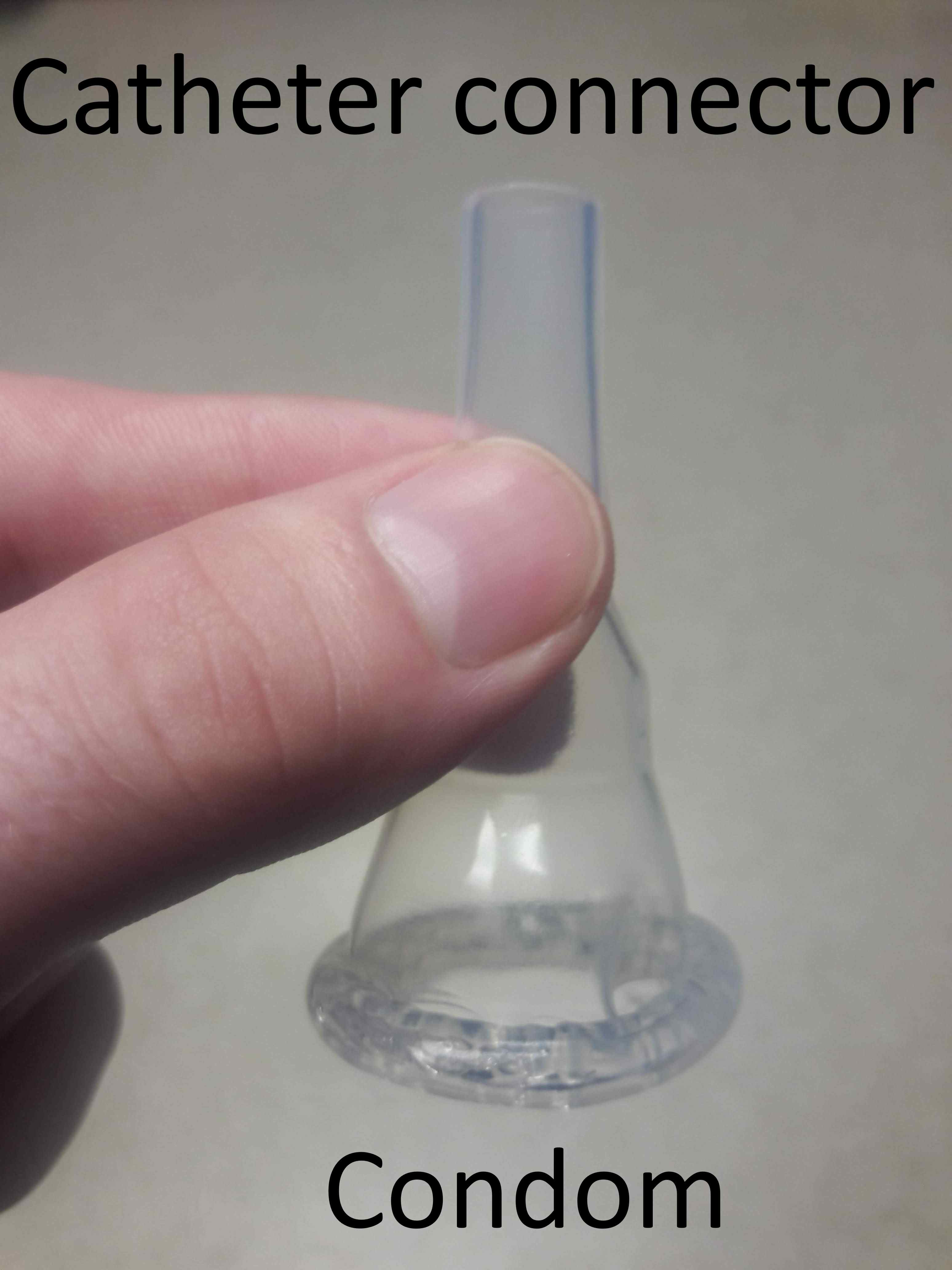 Condom catheter
Condom catheterA condom catheter is similar except it is not internal. They can only be used on males. It works very much like a condom hence the name. Instead of going inside the urethra, a stretchy plastic material that is attached to the tubing is wrapped around the penis. There are skin prep wipes and adhesive sprays that can be used to help the condom stay on the penis.
A straight catheter is only used for a very short amount of time. It still goes inside the urethra, but after all of the urine is drained out of the bladder, it is immediately taken back out. Some patients with bladder issues use these on themselves outside of the hospital. It can also be use in order to obtain a urine sample.
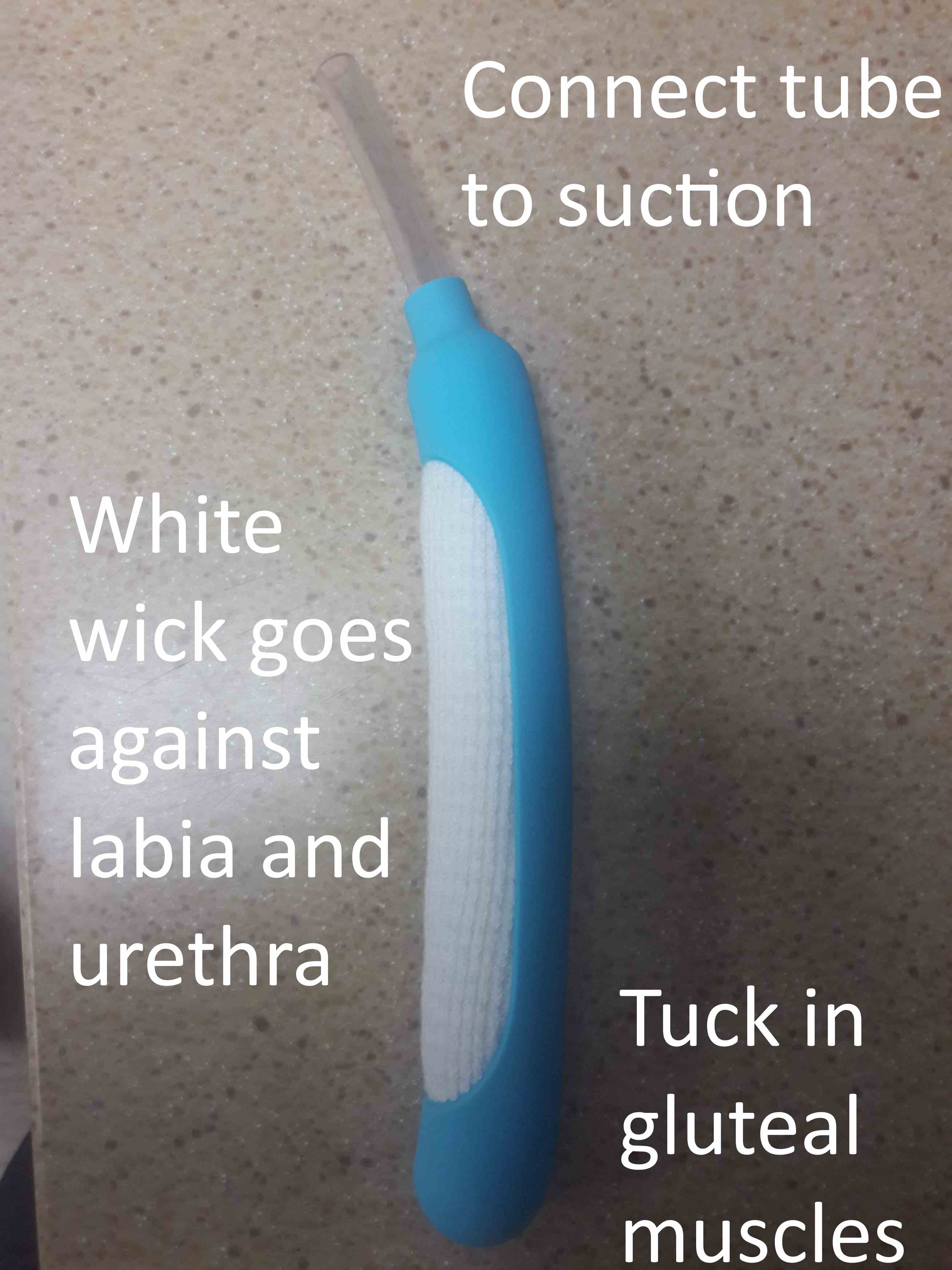 Purewick catheter
Purewick catheterPurewick Catheter
A purewick catheter is a fairly new device that allows for a female to have a catheter that isn't invasive. The only catch is that it is required to stay connected to low intermittent suction in order to work. If you have suction available to you, it is much preferred over an indwelling.
The device itself is banana shaped. It has a slight curve in order to snugly form around the groin area. It is a tube with wicks that are placed flush against the urethra that sucks the urine as the patient goes. It stretches from the labia to the gluteus. The end with the clear tubing faces upwards while the other end tucks between the gluteal muscles.
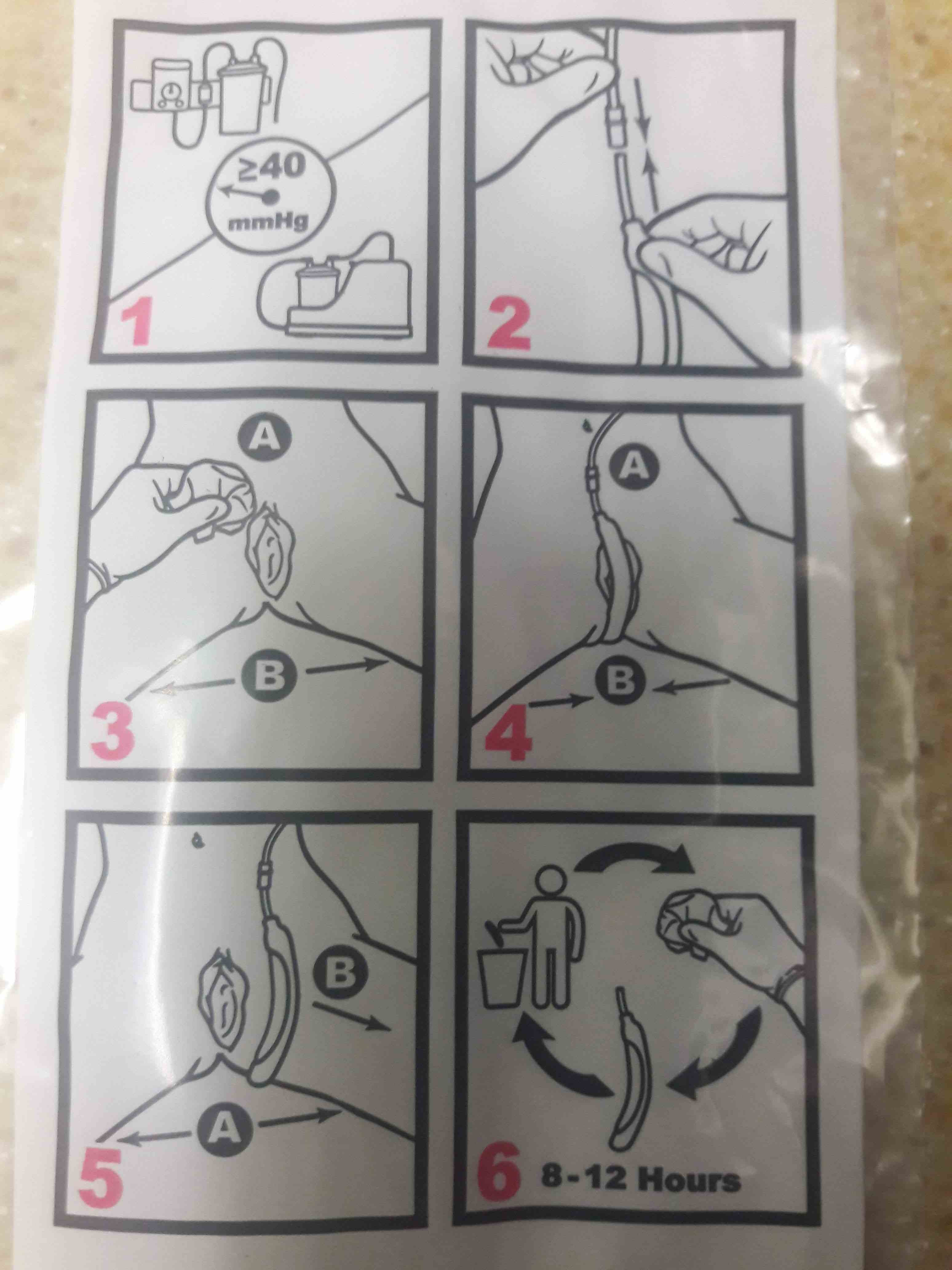 Purewick catheter instructions
Purewick catheter instructionsThe tube pointing upwards connects to a separate suction tubing which connects to the suction machine (wall vacuum) on the wall. This tube brings the urine to a canister that is also attached to the wall.
As the canister fills up, you have to empty it. To do this, you simply turn off the suction, take out the canister, and empty the contents out into the toilet. In order to measure the output, you either read the numbers on the canister, or simply empty it out into a graduate cylinder. Just don't forget to turn the suction back on afterwards.
The catheter should be replaced either every 8-12 hours, or when it is visibly soiled.
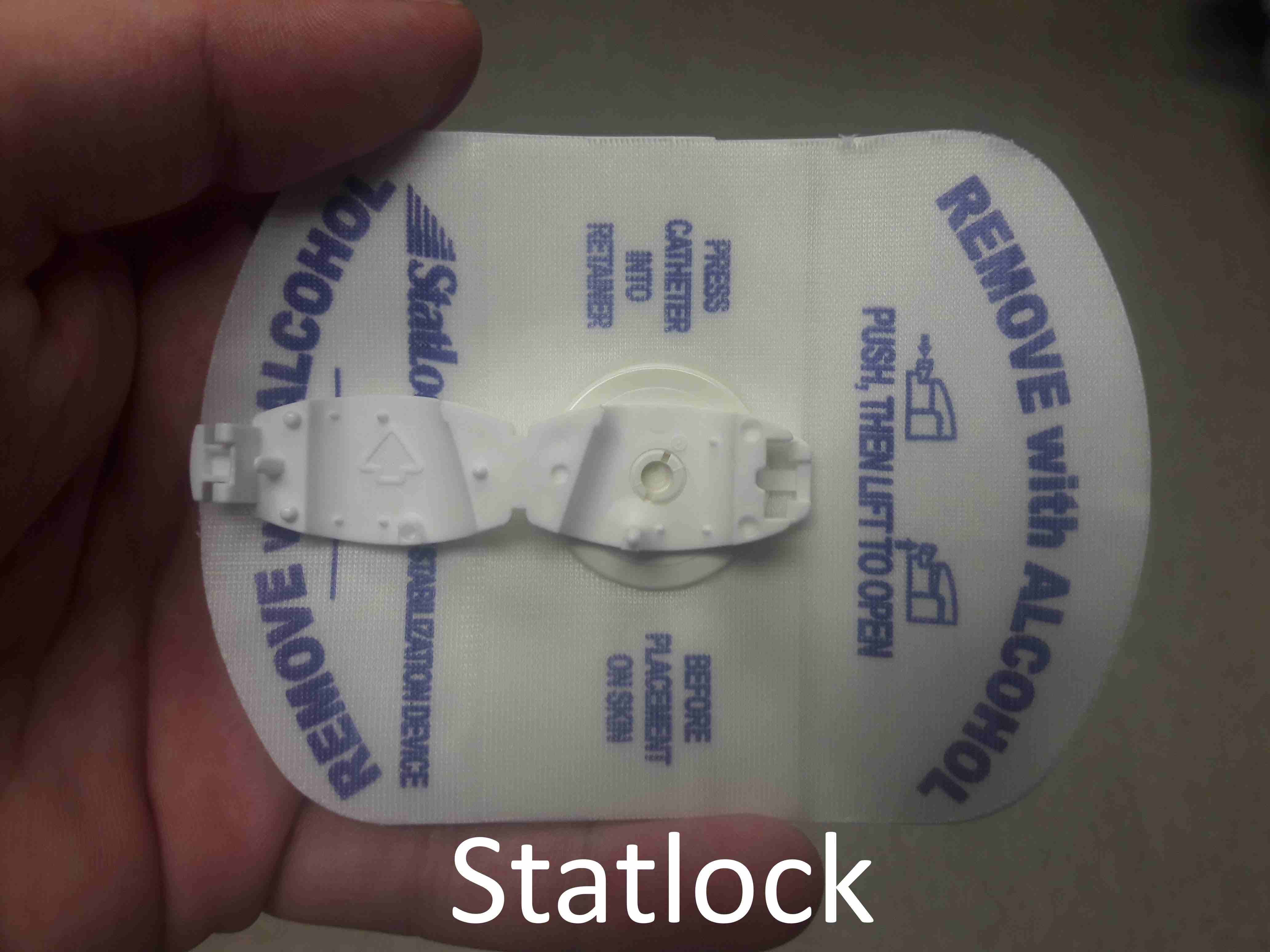 Statlock
StatlockAvoiding Injury
It's a good idea to make sure the tubing is not hanging out over the bed where it could possibly be tripped over which could cause injury. If necessary, coil the tubing and lay it next to the patient's leg on the bed.
It is common to attach the tubing to the leg with a special kind of tape or a device called a statlock (pictured) while the bag is placed next to the bed. This prevents the tubing from being tugged or worse, being pulled out.
This not only causes a lot of pain, it can also lead to injury. I have seen a foley catheter that had been pulled out and it is not a pleasant sight. Lots of blood was coming out of their urethra so I'm sure there was damage done internally.
The reason why it bleeds so much when pulled out is because water is pushed into the tubing towards the end which causes a tiny balloon to form. This keeps it in place and prevents it from slipping out. You must also be very careful when performing perineal care, which should be done at least every 12 hours.
In order to properly take it out, that balloon must be deflated by removing the water with a syringe. This will prevent injury from occurring since the tubing will flatten out and can slide out of the urethra with ease. A CNA is typically allowed to do this as long as they have been taught how to.
 Graduate cylinder
Graduate cylinderEmptying The Bag
Emptying a foley catheter is a very easy task. There is a short tube at the bottom of the bag with a clip attached. These clips come in various types but they all work similarly. Some of them have a little flap on the bag that the end of the tubing slides into so the tube doesn't drag the ground.
Just grab a graduate cylinder (picture) and place it underneath the tube. Unsnap the clip and let the urine drain from the bag into the graduate. Make sure the container doesn't overflow. If necessary, empty the contents and come back to finish draining the bag.
If you are measuring the output, make sure you set the graduate on a flat and level surface and wait for the urine to stop sloshing around in the container. Then bend down to eye level and observe to obtain a proper measurement.
Drain The Tubing
One trick I have learned to make sure you are emptying 100% of the urine is to drain all of the urine in the tubing leading to the bag. How do you do this?
You simply straighten out the tubing itself and make sure it is lower than the patient's bladder. You may have to tilt the tubing back and forth to drain all of it. It may take awhile to drain everything especially if more and more urine drains from the bladder into the tubing as you empty it.
The reason I emphasize doing this is because if it isn't done, excess urine could be left inside the bladder. This is not only uncomfortable for the patient, it could also cause a urinary tract infection (UTI).
I have had patients that appeared to not have any output from their foley catheter. But once I drained the tubing, more and more urine entered the tubing. The more I drained, the more urine came until there was over a thousand milliliters (mL) in the bag.
That means there was that much urine in their bladder. If I wouldn't have emptied the tubing and allowed more urine to drain, who knows how long the urine would've stayed in there.
I have encountered this situation multiple times. I always empty all of the urine out of the tubing before emptying the bag itself. You truly don't know how much output a patient has until you have done so.
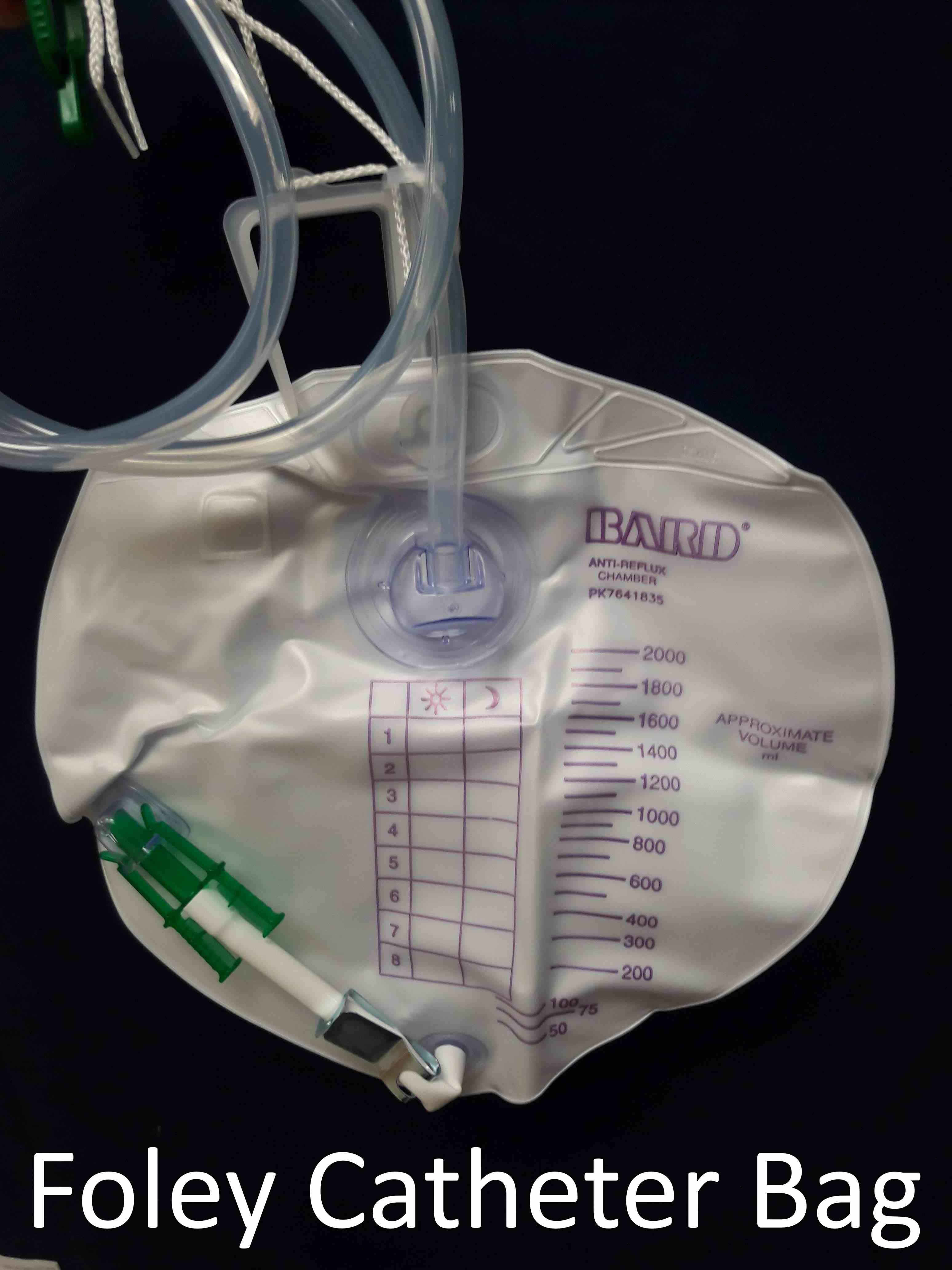 Foley catheter bag
Foley catheter bagPrevent Kinked Tubing
Make sure the tubing itself isn't kinked. A common way for it to become kinked is for the tubing to be underneath the patient's leg. Make sure the tubing goes over their leg so this doesn't happen.
An adult diaper could also kink the tubing. To prevent this, make sure it isn't too tight around their leg. Also, whichever side of the brief the tubing comes out of, make sure you hook the bag to the side of the bed on the same side.
Whenever a patient is being turned to help prevent bed sores, it is a good idea to place the bag on the side of the bed that the patient is leaning towards so the tubing won't go over the patient's higher leg. This allows the tubing to be as low from the patient's bladder as possible for better draining.
If these methods aren't working and you suspect their bladder may be full, use a bladder scanner if one is available to check.
Patients With Dementia
Many patients with dementia will forget they have a foley catheter or simply will not understand what it does. It often makes them feel like they have to urinate. This will often cause them to try to get up causing a fall risk or they may continually insist that they need bathroom assistance.
If this happens, you may have to remind them that they have one. Using the term "urine bag" may make it easier for them to understand. Explain what it is and what it does. I will sometimes show them the bag itself and point to the urine inside reemphasizing that they don't have to worry about using the bathroom.
Some patients may even attempt to pull out the tubing. If a patient attempts this, emphasize that not only will it hurt, pulling it out can also cause serious injury to their urethra. You may have to hide the tubing in order for them to leave it alone.
An easy way to do this would be to put an adult diaper on them. This may be all it takes to prevent them from tugging at it. Another method is to position the tubing to go all the way to the foot of the bed instead of over their leg. Just be sure the patient doesn't move their legs around or it may get pulled out.
When Should the Urinary Catheter be Removed?
Due to the high risk of catheter associated urinary tract infections (CAUTI), a urinary catheter should be removed as soon as possible. Here are some guidelines that will help determine if it should be kept in or removed.
Appropriate Indications
- Hematuria
- Continuous bladder irrigation (CBI)
- Urinary obstruction
- Urologic/Gynecologic surgery
- Decubitus ulcers: to assist in healing of open perineal or sacral wounds (stage 3 and 4) in incontinent patients
- Strict intake and output (I&O) that is critical for patient management or hemodynamic instability
- Neurogenic bladder dysfunction or chronic indwelling catheter
- Immobilization due to physical constraints such as a potentially unstable fracture, multiple traumatic injuries, epidural, femoral central venous catheter (CVC), palliative care, intra-aortic balloon pump (IABP), etc.
Inappropriate Indications
- Incontinence alone without any other justifiable reason
- Morbid obesity
- Dementia / confusion
- Patient request
- Nursing convenience
- Urine specimen collection: straight catheterize if unable to obtain otherwise
List of Caregiver Supplies and Equipment
From Foley Catheter Basic Info and Tips to Home
Recent Articles
-
Common Truck Crash Injuries and Legal Remedies - Caregiverology
Jul 19, 25 10:49 AM
Known for its sun-drenched beaches, vibrant arts scene, and bustling maritime industry, Fort Lauderdale is a city that sees heavy traffic both on its roads and at its busy port. Unfortunately, with th… -
Why Expert Legal Help Matters After Serious Injury - Caregiverology
Jul 19, 25 10:35 AM
In Houston, over 67,600 car crashes occurred in 2023, resulting in 290 fatalities and 1,612 serious injuries. That’s roughly 185 accidents every day. -
How Life Care Planners Support Injury Recovery - Caregiverology
Jul 19, 25 10:18 AM
In Los Angeles, life care planners play a vital role in supporting injury recovery, especially for individuals facing catastrophic injuries such as traumatic brain injuries or spinal cord damage.






New! Comments
Have something to say about what you just read? Leave a comment in the box below.